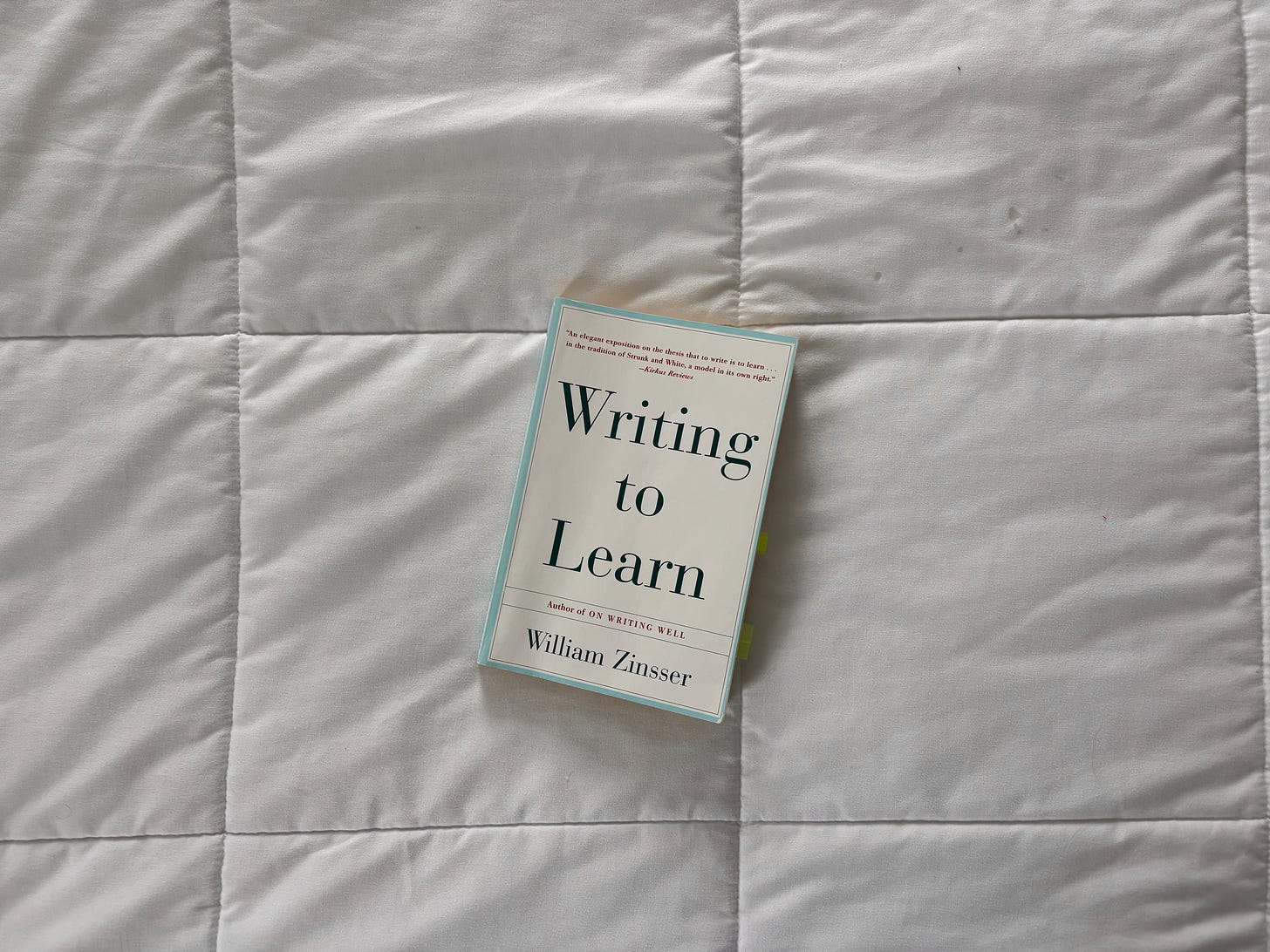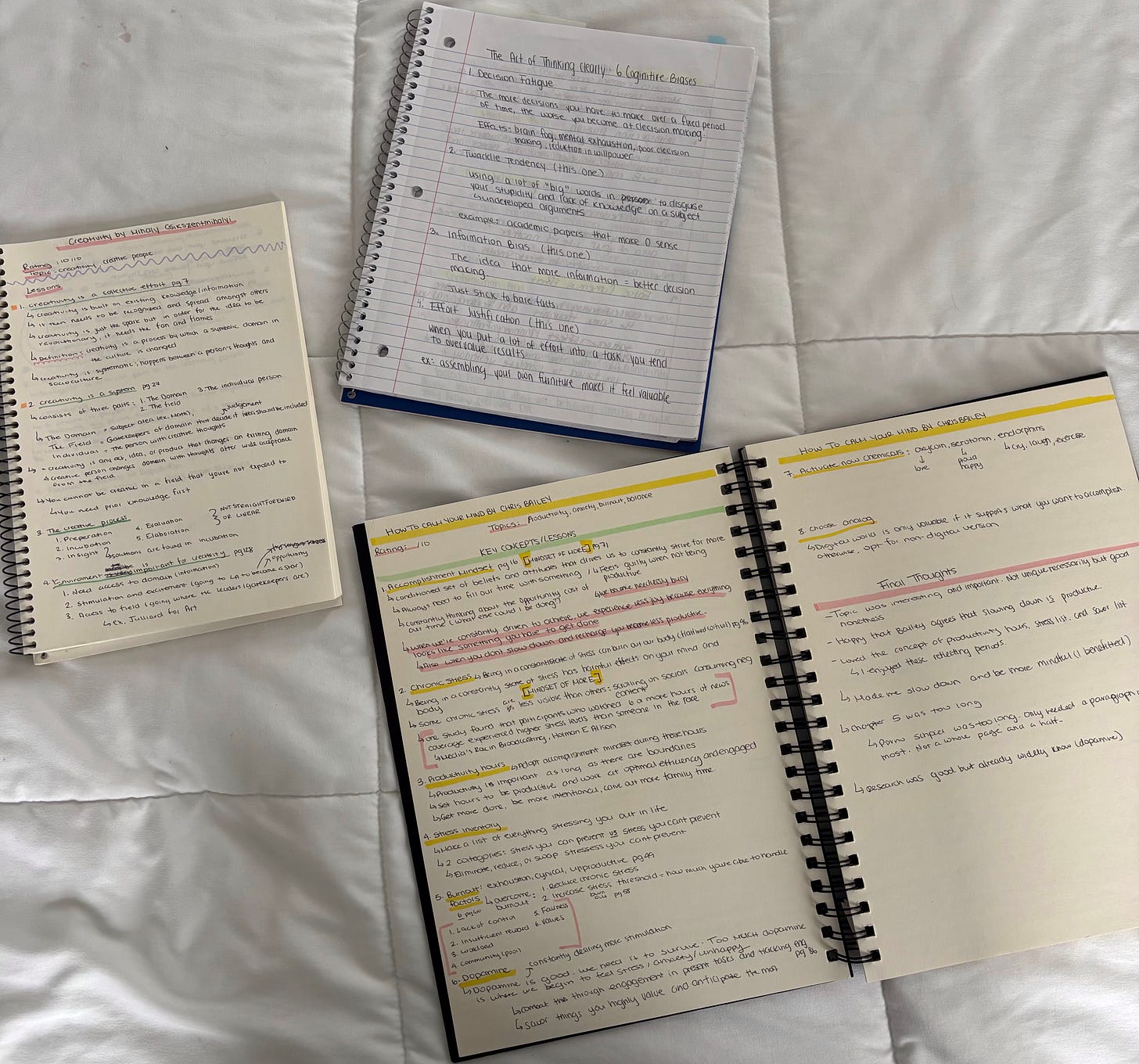how writing can help you learn and think better
from william zinsser's book "writing to learn"
One of my favourite books of 2024 was William Zinsser’s Writing to Learn. In his book, Zinsser highlights the connection between writing as a tool for learning, regardless of the subject.
Most people perceive writing solely as a creative pursuit, which I disagree with. Writing is a tool for communicating ideas; depending on the domain, it can be equally creative, informative, and technical.
Without writing, we wouldn’t have theories and their applications; without theory and the ability to communicate those theories effectively, we wouldn’t have the world we live in today.
If reading or listening are methods of consuming information, then writing is how we solidify our understanding of the information consumed. So, if you want to become a better learner and thinker, you first need to learn how to leverage writing as a tool to help you.
Why writing can help you become a better learner
Writing enhances your memory
When you learn something new, your brain begins to restructure and adapt, otherwise known as neuroplasticity.
Neuroplasticity can be quite a layered process so for the sake of simplicity, we’re only going to focus on two key players: neurons and the synapses. Neurons are the building blocks of the brain, required for information processing. Synapses are the bridges that connect neurons, allowing that information transfer to happen.
Neurons connect with each other through synapses, which act as links that allow them to communicate via chemical signals. Synapses are essential to neuroplasticity and learning because they are the sites where neurons exchange information and adapt in response to experiences. Simply put, whenever information is received — whether through observation, experience, or learning — the brain begins to form or strengthen neural connections through the synapses.
If you continue to repeat the information, you strengthen these synapses, which improves your memory and makes the information easier to recall.
If you don’t repeat what you’ve learned, the brain begins to prune unused synapses (a process called synaptic pruning) gradually eliminating these connections to make room for new ones. In other words, you slowly forget what you just learned.
This is where writing can be an effective tool to solidify our learning.
Let’s say you finished reading a book. You can either immediately jump into a new book or you can take the time to reflect and write about the one you just read.
If you start a new book immediately, without reflecting on the book you just read, you begin to form new neuron and synaptic connections. Consequently, the information from the previous book begins to fade (synaptic pruning).
On the other hand, by writing about what you’ve learned, you’re strengthening the existing neural connections in your brain. The more you repeat what you’ve learned, the stronger those neural connections become, making it easier to recall that exact information.
Organize your thoughts to think more clearly
William Zinsser states that, “Writing is a tool that enables people in every discipline to wrestle with facts and ideas…It compels us by the repeated effort of language to go after those thoughts and to organize them and present them clearly.”
Writing can help you organize your thoughts, taking the intangible and making it tangible. It forces you to structure your information and ideas, connecting them in a way that makes the most sense. When you write, you’re laying out all your existing information and confronting it, leaving room to dissect, connect, and challenge what’s presented.
As Zinsser also notes, “Anyone who thinks clearly should be able to write clearly – about any subject at all.”
Writing about a subject clearly and simply reflects that you have a strong understanding of it. Conversely, struggling to write about a subject signals that your comprehension of the topic still needs work.
Writing can help you identify your knowledge gaps
Like Zinsser, Albert Einstein also emphasized the importance of simplicity in writing, famously stating, “If you can’t explain it simply, then you don’t know it well enough.”
What I’d like to add to this quote is that discovering that you don’t know something well enough is a great thing.
For example, say you decide to write an article about climate change, and you’re having trouble explaining why fossil fuels are bad for the environment.
The mere fact that you can’t explain the impact of fossil fuels on the environment signals to your brain that you don’t know it well enough, so you have to conduct more research to understand it.
You then research the process and impact of fossil fuels on the environment and write it down as simply as possible (and in your own words). Without fully realizing it, you’ve just closed a knowledge gap and strengthened your understanding of a subject.
Now, when discussing climate change with a friend, you can explain why fossil fuels harm the environment instead of only saying they‘re harmful to the environment because they’re bad.
So, not only have you closed a knowledge gap you probably wouldn’t have known existed unless you wrote or spoke about the subject, but you can now explain your thinking without confusing yourself or the other person.
“Reading, writing, and thinking are all integrated..an idea can have value in itself, but its usefulness diminishes to the extent that you can’t articulate it to someone else.”
Kevin Bryne
How To Use Writing As A Tool For Learning
Note: These steps assume you already know what you want to learn. If not, the first step is to choose a topic and do thorough research before writing about it.
Create an information/learning journal
When I started reading books, I had trouble retaining the information, so I bought a blank journal and started writing down all the key concepts, lessons, and ideas I learned from each book. Eventually, I turned the information I had into content, which is where the creation of my book page, Books and Things Explained, came from.
Here’s how to start an information or learning journal
Buy a blank journal (physical) or start a Google Drive or Notion, where you’ll input all your information. I recommend writing instead of typing, but to each their own.
Split the information into groups.
I split my journals into books (non-fiction and fiction), miscellaneous, and learning goals (ex. Economics, Arabic, French)
Dedicate a set time to write in your journal or do it whenever (depending on your seriousness or discipline).
I bring my journal everywhere so I can write whenever I want. But if life gets too busy, I dedicate my Saturday and Sunday mornings to reviewing what I’ve read in books and writing them down in my journal.
Write
Once you’ve gathered your information in your journal, take it one step further and write about it in a structured format. Your preferred format is entirely up to you, but depending on the subject matter, I recommend writing either a blog post or an essay (mini, argumentative, expository, etc.).
If you’re having trouble connecting ideas or explaining them, make note of it. That means you need to do more research to strengthen your understanding.
Research and refine
As you begin to write, you’ll slowly identify knowledge gaps. Keep research and refining your ideas until you thoroughly understand the material and are able to explain it as simply as possible.
Conclusion
Taking the time to write about what you've learned helps solidify your understanding and makes it easier to recall later. By reflecting on your knowledge, sharing your insights, and recognizing where gaps remain, you develop not only clarity of thought but also the intellectual humility that drives deeper learning. In the end, this process makes you a sharper, more strategic thinker.



Rana, thank you for sharing this article. I joined Substack about a month ago and I've been thinking since then about how writing and thinking go together and how we might communicate better. Many of the articles I've written relate to thinking and communicating better, and your article gives me good ideas and suggestions for writing in the future. Keep up the good work!
Excellent post and good food for thought. I’m going to add this book to my list and look through my unused journals and notebooks. I’ve always found that I retain what I’ve learned by writing it down; your post is a good reminder to get back to that habit and make it intentional and consistent.